Configuration Example: Cisco Unity Express Networking
Available Languages
Contents
Introduction
Note: Although this configuration example provides summaries descriptions of certain procedures, the content assumes familiarity with the overall user interfaces for both Cisco Unity and Cisco Unity Express systems. Please refer to the appropriate command reference, configuration, and adminstrator's guides for detailed feature and capability descriptions for these products.
This document provides a sample configuration for a voice-mail configuration for Cisco Unity Express Voice Profile for Internet Mail (VPIM). In the example, VPIM connects two Cisco Unity Express sites and one Cisco Unity site. All three sites are under control of a central Cisco CallManager. The CallManager can be Cisco CallManager Express (CME) or Cisco Call Manager. For providing network connections between Cisco Unity Express and Cisco Unity, it does not matter which call manager supplies call control; the configuration for voice mail networking remains the same.
The configuration scenario in this document is for voice-mail networking among three sites. The configuration has the following characteristics:
- Meshed network --All sites can send voice messages to and receive voice messages from all other sites. Up to 500 Cisco Unity Express sites can be meshed in a network. Cisco Unity can send to and receive from a much larger number of sites (delivery locations).
- VPIM networking --In this example, the Cisco Unity system acts as the Domain Name System (DNS) server between sites.
- Four-digit dialing plan --Example of four-digit plan phone numbers: IP Phones at Site 4 (Cisco Unity Express) are 4001 and 4002, at Site 6 (Cisco Unity Express) they are 6001 and 6002, and at Site 7 (Cisco Unity) is 7006.
- No public switched telephone network (PSTN) connectivity --In the configurations of the three sites, PSTN connectivity has no relevance to the voice mail networking configuration. Real world offices networked together will include this PSTN connectivity configuration.
Prerequisites
Requirements
Before attempting this configuration, please ensure that you meet the following prerequisite:
Cisco Unity Express and Cisco Unity must run software releases capable of VPIM networking. This support starts with Cisco Unity Express Releasea 2.0 and Cisco Unity Release 4.03. The recommended releases are Cisco Unity Express Release 2.1 and Cisco Unity Release 4.04.
Components Used
The information in this document is based on these software and hardware versions:
- At Site 4, a Cisco 3725 router running Cisco Survivable Remote Site Telephony (SRST) and Cisco Unity Express
- At Site 6, a Cisco 3745 router running Cisco SRST and Cisco Unity Express
- At Site 7, a Cisco CallManager and Cisco Unity
- Cisco CallManager Release 4.0.1
- Cisco Unity 4.04
- Cisco IOS 12.3(11)T2 with the IP voice feature set
- Cisco Unity Express Release 2.1
All sites have Ethernet connections to the IP network. Sites 4 and 6 have two Cisco 7960 IP Phones each, and Site 7 has a single Cisco IP Phone. All IP Phones and dial plans are under control of the central Cisco CallManager, and the routers are configured for Cisco SRST operation.
The information in this document was created from the devices in a specific lab environment. All of the devices used in this document started with a cleared (default) configuration. If your network is live, make sure that you understand the potential impact of any command.
Related Products
This configuration can also be used with the following hardware and software versions:
- Cisco 2800 series routers.
- Cisco 3800 series routers.
- For Cisco 2800 series routers, Cisco IOS Release 12.3(8)T4 or later releases. For Cisco 3800 series routers, Cisco IOS Release 12.3(11)T and later releases.
Conventions
The conventions listed in Table 1 are used in this document.
Table 1 Conventions Used in This Document
| Convention |
Description |
| boldfaced text |
Boldfaced text is used for:
|
| < > (angle brackets) |
Angle brackets are used around a parameter for which you supply a value. (Example: In the Command Prompt window, enter ping <IP address>.) |
| - (hyphen) |
Hyphens join keys that must be pressed simultaneously. (Example: Press Ctrl - Alt - Delete .) |
| > (right angle bracket) |
A right angle bracket is used to separate selections that you make:
|
| The letter a used in the high-order address range for an IP V4-formatted address. |
Represents a public Class A Internet address or network. Used for illustrative purposes only in order to prevent the use of public numbers. (Example: a.23.10.224.) |
| The letters x and y used within phone numbers. |
Represents the area code and prefix for a telephone number. Used for illustrative purposes only in order to prevent the use of public numbers. (Example: 2xx.yyy.1234.) |
The following conventions for Notes and Cautions are also used in this document:
Note: Means reader take note. Notes contain helpful suggestions or references to material not covered in the document.
Caution: Means reader be careful. In this situation, you might do something that could result in equipment damage or loss of data.
Configure
In this section, you are presented with the information to configure the features described in this document.
Note: To find additional information on the commands used in this document, use the Command Lookup Tool (registered customers only).
Network Diagram
This document uses the network setup shown in the diagram below.
Figure 1 Network Diagram Showing Cisco Unity Express Networked with Cisco Unity
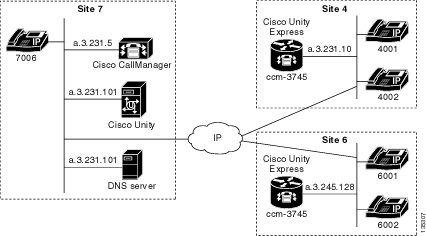
The Site 4 location has the following characteristics:
- Cisco 3725 router with an NM-CUE
- IP network access through IP address a.3.231.10
- Cisco CallManager/Cisco SRST configuration with two Cisco IP Phones (extensions 4001 and 4002)
- Cisco Unity Express IP address a.3.231.128
- Network location ID 444
- Cisco Unity Express DNS domain name ch4.cue.cisco.com
The Site 6 location has the following characteristics:
- Cisco 3745 router with an NM-CUE
- IP network access through IP address a.3.245.1
- Cisco CallManager/Cisco SRST configuration with two Cisco IP Phones (extensions 6001 and 6002)
- Cisco Unity Express IP address a.3.245.128
- Network location ID 666
- Cisco Unity Express DNS domain name ch6.cue.cisco.com
The Site 7 location has the following characteristics:
- Cisco Call Manager with IP address a.3.231.5
- One Cisco IP Phone (extension 7006)
- Cisco Unity with IP address a.3.231.101
- Network location ID 777
- Cisco Unity DNS domain name unity.unity.cisco.com
- DNS server (hosted by the Cisco Unity server) with IP address a.3.231.101
Configurations
This document uses the configurations shown below:
Configuring VPIM on Cisco Unity Express
Use these steps to set up a VPIM networking configuration on Cisco Unity Express:
| Step 1 |
Configure a DNS server and specify its IP address. |
| Step 2 |
Define all other locations that you want to network. |
| Step 3 |
For each location, specify:
|
| Step 4 |
Set the local location ID (define which of the sites is local). |
Configuring VPIM on Cisco Unity
Use these steps to set up a VPIM networking configuration on Cisco Unity:
| Step 1 |
Define the primary location (the local site). |
| Step 2 |
Define a delivery location for each remote site with which you want to network. |
| Step 3 |
For each Delivery Location, specify:
|
| Step 4 |
Configure the Unity Voice Connector (UVC) on Cisco Unity to set up Windows Exchange for SMTP (that is, VPIM) traffic. |
Configuring DNS
Use these general steps to set up the DNS server.
Optional Configuration Elements
The following elements are optional configuration elements:
- You can record spoken names using the Administration via Telephony (AVT) interface on Cisco Unity Express. This gives the message sender a spoken confirmation for the destination location (instead of a numeric read-out of the location ID).
- You can record spoken names for delivery locations can be recorded on Cisco Unity.
- You can define remote users in the Cisco Unity Express static directory (and spoken names can be recorded for them through the AVT), so that a person gets a name confirmation when addressing a message to one of these remote users.
- You can send spoken-name and vCard information with each message to update Cisco Unity or Cisco Unity Express directories and to aid in message header playout of the message to the recipient. With Cisco Unity Express, spoken-name and vCard information is sent by default. With Cisco Unity, the default configuration calls for the information not to be sent--explicit configuration is required on the delivery location (for the sending site) in order to include this information.
Implementing vCard and spoken-name information helps to have more explicit info in the message header playout to the recipient. For example, when you retrieve your voicemail without vCard and spoke-name information, the header of a new message might play out as follows: "Message received from an unknown number today at 3:20 p.m." With vCard information, message header might play out as follows: "Message received from extension yyy9756 today at 3:20 p.m." With vCard and spoken-name informattion, the message header might play out as follows: "Message received from Jane Doe today at 3:20 p.m."
- You can configure phone prefixes to allow a limited amount of digit manipulation of destination addressing digits that are sent with the message via VPIM.
- Cisco Unity Express allows you to configure minimum and maximum values for the length of an extension of a site. This allows the sending system to do a limited amount of error checking on blind addresses.
- Two message formats (G.711 and G.726) are supported. You can select the format you prefer.
Limitations and Restrictions
The following considerations apply to the setting up of VPIM networking between Cisco Unity Express and Cisco Unity:
- Each location ID (dial ID) must contain at least three digits.
- Network addressing must be done through DNS (in other words, with hostnames). Direct IP addresses can be used for networking between Cisco Unity Express sites, but they cannot be used if any of the sites in the network are Cisco Unity systems.
- If network broadcast messaging is used, the VPIM broadcast ID on Cisco Unity Express must be configured to be numeric only. The default string (vpim-broadcast) is alphanumeric and cannot be used to network with Cisco Unity.
- Cisco Unity Express allows configuration of up to 500 sites (one local and up to 499 remote).
- A redirect server (such as sendmail) can technically be used to redirect SMTP messages for VPIM networking between Cisco Unity Express and Cisco Unity, but this is an untested and unsupported configuration.
- Each domain suffix must be unique within the Cisco Unity Express and Cisco Unity sites. For example, naming the sites cue4.cisco.com, cue6.cisco.com, and unity.cisco.com does not work, because the suffix for all sites is cisco.com. Instead use a scheme such as cue4.cue.cisco.com, cue6.cue.cisco.com, and unity.unity.cisco.com. This scheme distinguishes between the cue.cisco.com and unity.cisco.com domains.
| Step 1 |
Set up a hostname IP address ( A record) for each Cisco Unity Express and Cisco Unity system. |
| Step 2 |
Set up a mail server hostname ( MX record) for each Cisco Unity Express or Cisco Unity system. |
Verifying Network Connectivity
This section provides information you can use to confirm your configuration is working properly.
Certain show commands are supported by the Output Interpreter Tool (registered customers only), which allows you to view an analysis of show command output.
Before attempting to send networked voice mails between sites, make sure you can:
Cisco Unity Express Site 4 Configuration
This section gives details for configuring the Cisco Unity Express system at Site 4. The first section provides selected screen shots of the GUI networking setup, and the second section presents the full running configuration in command line format.
Using the GUI for Configuration
Here are the steps for configuring Cisco Unity Express at Site 4 using the Cisco Unity Express GUI tool:
| Step 1 |
Configure the DNS server for Cisco Unity Express at Site 4 via the Administration > Domain Name Settings window. See Figure 2 . Figure 2 Configuring the DNS Server for Site 4 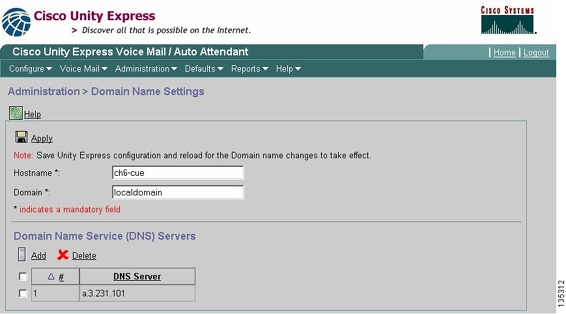 |
| Step 2 |
Configure the local and remote locations for Site 4 via the Administration Adminstration > Networking Locations window. See Figure 3 . Figure 3 Configuring Local and Remote Locations for Site 4  |
| Step 3 |
Configure the details of the local location (ID 444) for Site 4. See Figure 4 . Figure 4 Configuring Local Location Details for Site 4 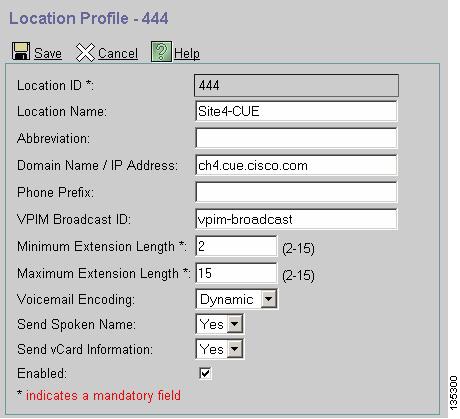 |
| Step 4 |
(Optional) Configure each user at a remote site (Site 6) so that a spoken name is given when a message is addressed to one of them, even though no messages have been received from the specified user. Perform this step with the Configure > Remote Users window. See Figure 5 . Note: Cisco Unity Express maintains an internal, cached directory. Once a message has been received from a remote user, the spoken name that arrived with that message is available in the cached directory. Permitting a system administrator to record spoken names for remote users serves two purposes. First, if the administrator does not record the name, there is nothing in the local cache to play until a message is received from a specific user, because the cached directory starts off empty. The system administrator can record something that remains in the cached directory until it is overwritten with more recent information gathered from a message received from the user. Second, messages from remote users might never be received in some network designs--the users might only be able to receive messages. In these situations, the cache never gets automatically updated; the only way to get a spoken name entered is for the system administrator to record it. Figure 5 Configuring Users at a Remote Site 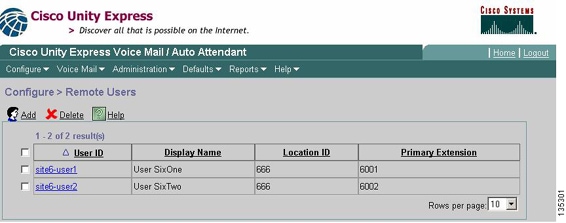 |
| Step 5 |
Configure the details of a user at a remote site (Site 6). See Figure 6 . Figure 6 Configuring Details for a Remote User 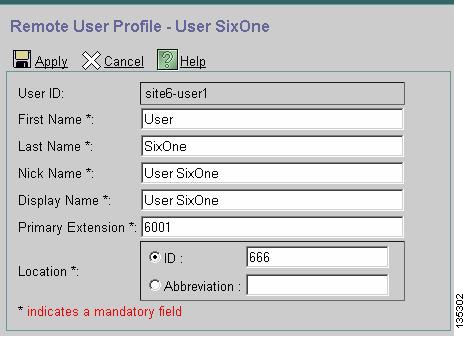 |
Using the CLI for Configuration
The following command listing is an example of Cisco Unity Express CLI configuration for Cisco Unity Express at Site 4:
Note: Important configuration commands are highlighted within the configuration by embedded comments that precede each of these key commands.
| Configure Cisco Unity Express at Site 4 according to the following example.
ch4-cue#
show running-config
Generating configuration:
clock timezone America/Los_Angeles
hostname ch4-cue
ip domain-name localdomain
!
! DNS server
!
ip name-server a.3.231.101
ntp server a.3.231.10
software download server url "ftp://127.0.0.1/ftp"
credentials hidden "6u/dKTN/hsEuSAEfw40XlF2eFHnZfyUTSd8ZZNgd+Y9J3xlk2B35j0nfGWTYHfmPSd8ZZNgd+Y9J3xlk2B35jwAAAAA="
groupname Administrators create
groupname Broadcasters create
username admin create
!
! Local users and extensions
!
username user1 create
username user2 create
username user1 phonenumberE164 "4xxyyy4001"
username user2 phonenumberE164 "4xxyyy4002"
username user1 phonenumber "4001"
username user2 phonenumber "4002"
groupname Administrators member admin
groupname Administrators privilege superuser
groupname Administrators privilege ManagePrompts
groupname Administrators privilege ManagePublicList
groupname Administrators privilege ViewPrivateList
groupname Broadcasters privilege broadcast
backup server url "ftp://a.3.231.32/ch4-cue-9jan05/"
credentials hidden "xxOaioWv/uC5WSZLs/L2XY/frZzvmJ2MSd8ZZNgd+Y9J3xlk2B35j0nfGWTYHfmPSd8ZZNgd+Y9J3xlk2B35jwAAAAA="
calendar biz-schedule systemschedule
open day 1 from 00:00 to 24:00
open day 2 from 00:00 to 24:00
open day 3 from 00:00 to 24:00
open day 4 from 00:00 to 24:00
open day 5 from 00:00 to 24:00
open day 6 from 00:00 to 24:00
open day 7 from 00:00 to 24:00
end schedule
ccn application autoattendant
description "autoattendant"
enabled
maxsessions 8
script "aa.aef"
parameter "busOpenPrompt" "AABusinessOpen.wav"
parameter "holidayPrompt" "AAHolidayPrompt.wav"
parameter "busClosedPrompt" "AABusinessClosed.wav"
parameter "allowExternalTransfers" "false"
parameter "MaxRetry" "3"
parameter "operExtn" "0"
parameter "welcomePrompt" "AAWelcome.wav"
parameter "businessSchedule" "systemschedule"
end application
ccn application ciscomwiapplication
description "ciscomwiapplication"
enabled
maxsessions 8
script "setmwi.aef"
parameter "strMWI_OFF_DN" "8001"
parameter "strMWI_ON_DN" "8000"
parameter "CallControlGroupID" "0"
end application
ccn application promptmgmt
description "promptmgmt"
enabled
maxsessions 1
script "promptmgmt.aef"
end application
ccn application voicemail
description "voicemail"
enabled
maxsessions 8
script "voicebrowser.aef"
parameter "logoutUri" "http://localhost/voicemail/vxmlscripts/mbxLogout.jsp"
parameter "uri" "http://localhost/voicemail/vxmlscripts/login.vxml"
end application
ccn engine
end engine
ccn subsystem jtapi
ctiport 4901 4902 4903 4904
ccm-manager address a.3.231.5
ccm-manager
credentials hidden "QiUfMZRFsRBqrOHVxftjAknfGWTYHfmPSd8ZZNgd+Y9J3xlk2B35j0nfGWTYHfmPSd8ZZNgd+Y9J3xlk2B35jwAAAAA="
end subsystem
ccn subsystem sip
gateway address "a.3.231.10"
end subsystem
ccn trigger jtapi phonenumber 4100
application "autoattendant"
enabled
locale "en_US"
maxsessions 8
end trigger
ccn trigger jtapi phonenumber 4105
application "voicemail"
enabled
locale "en_US"
maxsessions 8
end trigger
ccn trigger jtapi phonenumber 4106
application "promptmgmt"
enabled
locale "en_US"
maxsessions 1
end trigger
ccn trigger sip phonenumber 4100
application "autoattendant"
enabled
locale "en_US"
maxsessions 8
end trigger
ccn trigger sip phonenumber 4105
application "voicemail"
enabled
locale "en_US"
maxsessions 8
end trigger
ccn trigger sip phonenumber 4106
application "promptmgmt"
enabled
locale "en_US"
maxsessions 1
end trigger
!
! Networking configuration for Sites 4, 6 and 7
!
network location id 444
email domain ch4.cue.cisco.com
name "Site4-CUE"
end location
network location id 666
email domain ch6.cue.cisco.com
name "Site6-CUE"
end location
network location id 777
email domain unity.unity.cisco.com
name "Site7-Unity"
end location
!
! Local site definition -- Site 4
!
network local location id 444
!
! Remote users
!
remote username site6-user1 location 666 create
remote username site6-user2 location 666 create
remote username site6-user1 phonenumber 6001
remote username site6-user2 phonenumber 6002
voicemail default language en_US
voicemail default mailboxsize 3000
voicemail broadcast recording time 300
voicemail capacity time 6000
voicemail mailbox owner "user1" size 3000
description "user1 mailbox"
end mailbox
voicemail mailbox owner "user2" size 3000
description "user2 mailbox"
end mailbox
end
|
Cisco Unity Express Site 6 Configuration
This section gives details for configuring the Cisco Unity Express system at Site 6. The first section provides selected screen shots of the GUI networking setup, and the second section presents the full running configuration in command line format.
Using the GUI for Configuration
Here are the steps for configuring Cisco Unity Express at Site 6 using the Cisco Unity Express GUI tool:
| Step 1 |
Configure the DNS server for Cisco Unity Express at Site 6 via the Adminstration > Domain Name Settings window. See Figure 7 . Figure 7 Configuring the DNS Sever for Site 6 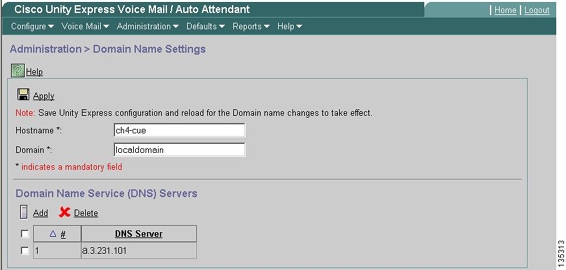 |
| Step 2 |
Configure the local and remote locations for Site 6 via the Adminstration > Network Locations window. See Figure 8 . Figure 8 Configuring Local and Remote Locations for Site 6  |
| Step 3 |
Configure the details of the local location (ID 666) for Site 6. See Figure 9 . Figure 9 Configuring Details for Local Location for Site 6 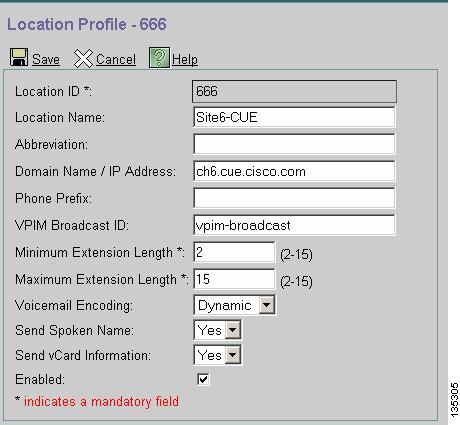 |
| Step 4 |
(Optional) Using the Configure > Remote Users window, onfigure each user at a remote site (Site 4) so that a spoken name is given when a message is addressed to a specific user, even though no messages have been received from that user. See Figure 10 . Note: Cisco Unity Express maintains an internal, cached directory. Once a message has been received from a remote user, the spoken name that arrived with that message is available in the cached directory. Permitting a system administrator to record spoken names for remote users serves two purposes. First, if the administrator does not record the name, there is nothing in the local cache to play until a message is received from a specific user, because the cached directory starts off empty. The system administrator can record something that remains in the cached directory until it is overwritten with more recent information gathered from a message received from the user. Second, messages from remote users might never be received in some network designs--the users might only be able to receive messages. It these situations, the cache never gets automatically updated, and the only way to get a spoken name entered is for the system administrator to record it. Figure 10 Configuring Users at a Remote Site  |
| Step 5 |
Configure the details of a user at a remote site (Site 4). See Figure 11 . Figure 11 Configuring Details for Remote User 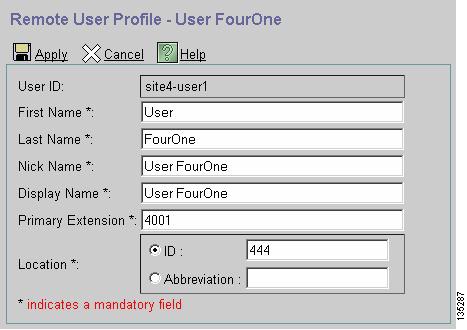 |
Using the CLI for Configuration
The following command listing is an example of Cisco Unity Express CLI configuration for Cisco Unity Express at Site 6:
Note: Important configuration commands are highlighted within the configuration by embedded comments that precede each of these key commands.
| Configure Cisco Unity Express at Site 6 according to the following example
ch6-cue#
show running-config
Generating configuration:
clock timezone America/Los_Angeles
hostname ch6-cue
ip domain-name localdomain
!
! DNS server
!
ip name-server a.3.231.101
ntp server a.3.233.100
ntp server a.3.245.1
software download server url "ftp://127.0.0.1/ftp"
credentials hidden "6u/dKTN/hsEuSAEfw40XlF2eFHnZfyUTSd8ZZNgd+Y9J3xlk2B35j0nfGWTYHfmPSd8ZZNgd+Y9J3xlk2B35jwAAAAA="
groupname Administrators create
groupname Broadcasters create
!
! Local users and extensions
!
username admin create
username user1 create
username user2 create
username user1 phonenumberE164 "6xxyyy6001"
username user2 phonenumberE164 "6xxyyy6002"
username user1 phonenumber "6001"
username user2 phonenumber "6002"
groupname Administrators member admin
groupname Administrators privilege superuser
groupname Administrators privilege ManagePrompts
groupname Administrators privilege ManagePublicList
groupname Administrators privilege ViewPrivateList
groupname Broadcasters privilege broadcast
backup server url "ftp://a.3.231.32/ch6-cue-9jan05/"
credentials hidden "xxOaioWv/uC5WSZLs/L2XY/frZzvmJ2MSd8ZZNgd+Y9J3xlk2B35j0nfGWTYHfmPSd8ZZNgd+Y9J3xlk2B35jwAAAAA="
ccn application autoattendant
description "autoattendant"
enabled
maxsessions 8
script "aa.aef"
parameter "busOpenPrompt" "AABusinessOpen.wav"
parameter "holidayPrompt" "AAHolidayPrompt.wav"
parameter "busClosedPrompt" "AABusinessClosed.wav"
parameter "allowExternalTransfers" "true"
parameter "MaxRetry" "3"
parameter "operExtn" "0"
parameter "welcomePrompt" "AAWelcome.wav"
parameter "businessSchedule" "systemschedule"
end application
ccn application ciscomwiapplication
description "ciscomwiapplication"
enabled
maxsessions 8
script "setmwi.aef"
parameter "strMWI_OFF_DN" "8001"
parameter "strMWI_ON_DN" "8000"
parameter "CallControlGroupID" "0"
end application
ccn application promptmgmt
description "promptmgmt"
enabled
maxsessions 1
script "promptmgmt.aef"
end application
ccn application voicemail
description "voicemail"
enabled
maxsessions 8
script "voicebrowser.aef"
parameter "logoutUri" "http://localhost/voicemail/vxmlscripts/mbxLogout.jsp"
parameter "uri" "http://localhost/voicemail/vxmlscripts/login.vxml"
end application
ccn engine
end engine
ccn subsystem jtapi
ctiport 6901 6902 6903 6904
ccm-manager address a.3.231.5
ccm-manager
credentials hidden "1anJW38IVSZld67dzhL9pEnfGWTYHfmPSd8ZZNgd+Y9J3xlk2B35j0nfGWTYHfmPSd8ZZNgd+Y9J3xlk2B35jwAAAAA="
end subsystem
ccn subsystem sip
gateway address "a.3.45.1"
end subsystem
ccn trigger jtapi phonenumber 6100
application "autoattendant"
enabled
locale "en_US"
maxsessions 8
end trigger
ccn trigger jtapi phonenumber 6105
application "voicemail"
enabled
locale "en_US"
maxsessions 8
end trigger
ccn trigger jtapi phonenumber 6106
application "promptmgmt"
enabled
locale "en_US"
maxsessions 1
end trigger
ccn trigger sip phonenumber 6100
application "autoattendant"
enabled
locale "en_US"
maxsessions 8
end trigger
ccn trigger sip phonenumber 6105
application "voicemail"
enabled
locale "en_US"
maxsessions 8
end trigger
ccn trigger sip phonenumber 6106
application "promptmgmt"
enabled
locale "en_US"
maxsessions 1
end trigger
!
! Networking configuration for Sites 4, 6 and 7
!
network location id 444
email domain ch4.cue.cisco.com
name "Site4-CUE"
voicemail phone-prefix yyy
end location
network location id 666
email domain ch6.cue.cisco.com
name "Site6-CUE"
end location
network location id 777
email domain unity.unity.cisco.com
name "Site7-Unity"
end location
!
! Local site definition - Site 6
!
network local location id 666
!
! Remote users
!
remote username site4-user1 location 444 create
remote username site4-user2 location 444 create
remote username site4-user1 phonenumber 4001
remote username site4-user2 phonenumber 4002
voicemail default language en_US
voicemail default mailboxsize 3000
voicemail broadcast recording time 300
voicemail capacity time 6000
voicemail mailbox owner "user1" size 3000
description "user1 mailbox"
end mailbox
voicemail mailbox owner "user2" size 3000
description "user2 mailbox"
end mailbox
end |
Cisco Unity Site 7 Configuration
This section gives details for configuring the Cisco Unity system at Site 7. The first section provides screen shots of the delivery locations, and the second section presents details about the Exchange/UVC configuration.
Configuring Delivery Locations
Here are the steps for configuring Cisco Unity at Site 7 using the Cisco Unity GUI tool:
| Step 1 |
Configure the primary location (local location) for Site 7. See Figure 12 . Figure 12 Configuring the Primary Location 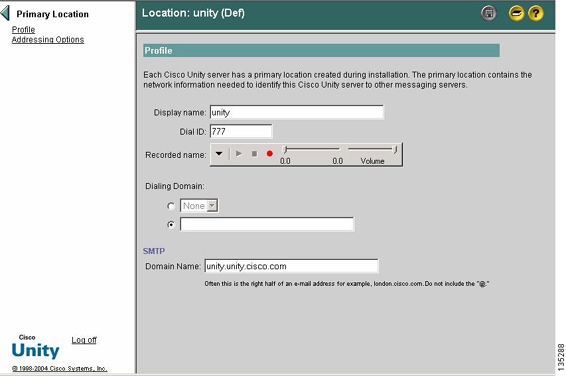 |
| Step 2 |
Configure the delivery location for remote Site 4. Mark the Destination Type as VPIM. Check the Sender's Recorded Name and Sender's vCard attributes if you want this information to be sent with the VPIM message. See Figure 13 . Figure 13 Configuring the Delivery Location for Remote Site 4  |
| Step 3 |
Configure the Delivery Location for remote Site 6. Mark the Destination Type as VPIM. Check the Sender's Recorded Name and Sender's vCard attributes if you want this information to be sent with the VPIM message. See Figure 14 . Figure 14 Configuring the Delivery Location for Remote Site 6 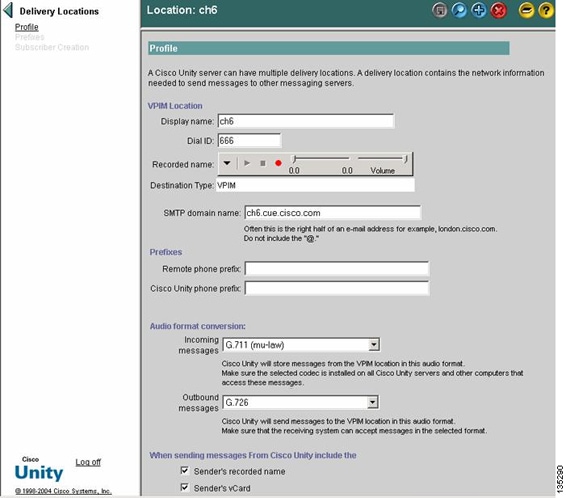 |
| Step 4 |
Show a summary screen displaying all of the remote locations in the network. To do this, choose Delivery Locations from the main Cisco Unity window. Perform a wildcard find (*) on all the locations defined in the system. Figure 15 illustrates an example of the output that results. Figure 15 Display of Summary Screen for Remote Locations 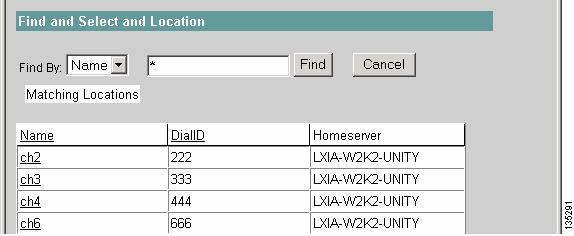 |
Verifying Microsoft Exchange and UVC Configuration
Use the following procedure to verify the Microsoft Exchange and UVC configuration for Cisco Unity:
| Step 1 |
Go to Programs > Microsoft Exchange > System Manager . |
| Step 2 |
In the Exchange System Manager window, click Recipient > Recipient Policies . In the right panel, the display shows Default Policy. Right click Default Policy and select Properties . In the Default Policy Properties pop-up window, select E-Mail Address (Policy). The SMTP parameter should show the domain name of the Cisco Unity server (such as unity.unity.cisco.com). See Figure 16 . Figure 16 Exchange System Manager Recipient Policies Window 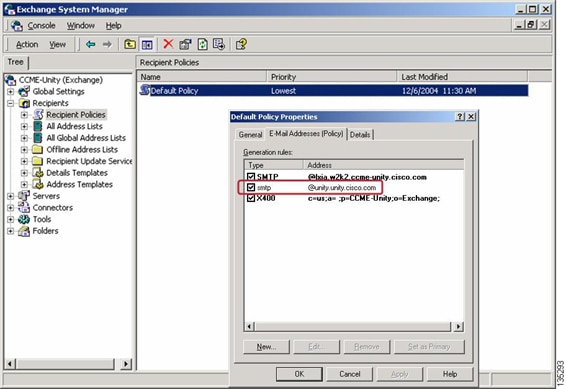 |
| Step 3 |
In the Exchange System Manager window, go to Connectors > Exchange 2000 Voice Connector > Queues. MTS-IN and MTS-OUT queues must exist. See Figure 17 . Figure 17 Exchange System Manager Queries Window 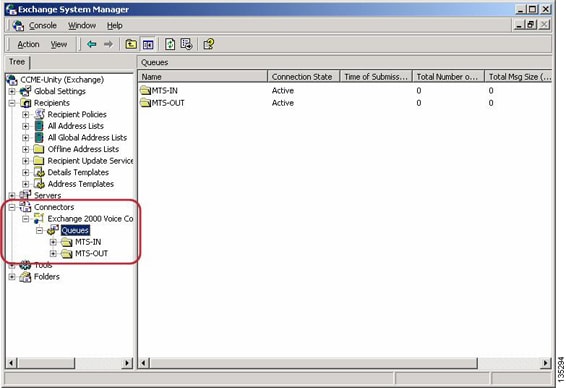 |
| Step 4 |
In the Registry Editor window, ensure that the TargetDomain shows the local Cisco Unity domain name (such as unity.unity.cisco.com). See Figure 18. Figure 18 Registry Editor Window 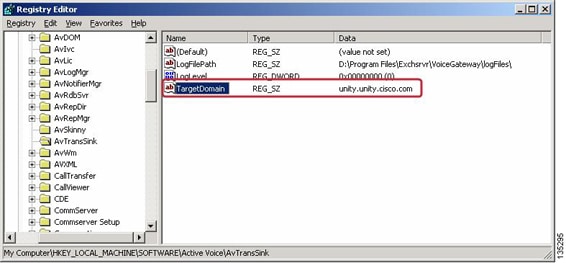 |
Configuring the DNS
The DNS server must have an entry for each of the domains associated with the Cisco Unity Express and Cisco Unity network configuration.
| Configure an entry for each of the domains associated with the Cisco Unity Express and Cisco Unity network configuration on the DNS server. Figure 19 shows the DNS setup for Cisco Unity Express (cue.cisco.com domain). Figure 19 DNS Setup Window for Cisco Unity Express 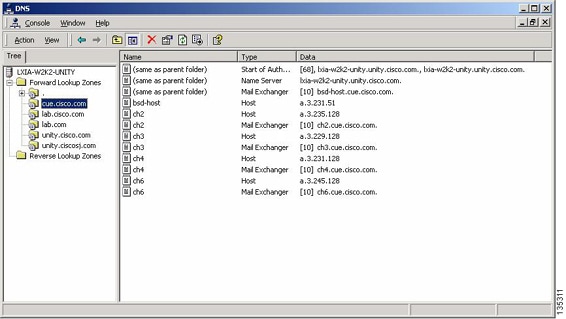 Figure 20 shows the DNS setup window for Cisco Unity (unity.cisco.com domain). Figure 20 DNS Setup Window for Cisco Unity 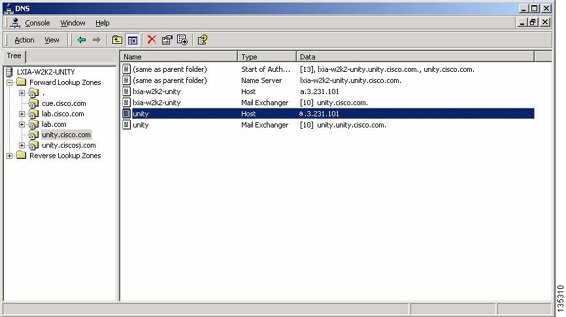 Each site requires a Host (A) and a Mail Exchange (MX) record. See Figure 21 . Figure 21 Mail Exchange Record Property Windows 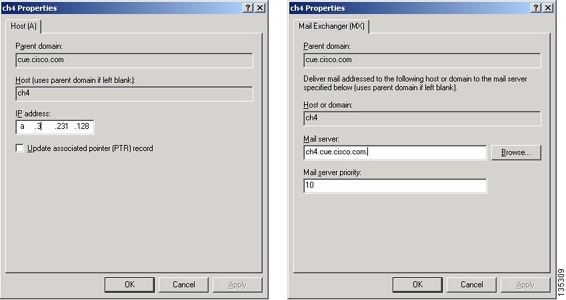 |
Verify
This section provides information you can use to confirm that your configuration is working properly.
Verifying DNS Server Connectivity
Perform these steps to verify DNS server connectivity.
| Step 1 |
Enter the show hosts command to show the configuration of a DNS server. The following is an output example for the show hosts command, performed on the Cisco Unity Express CLI of the Site 4 system. It shows the configuration of a DNS server.
ch4-cue#
show hosts
Hostname: ch4-cue
Domain: localdomain
DNS Server1: a.3.231.101
|
| Step 2 |
To confirm server connectivity, verify that you can ping between all the Cisco Unity Express and Cisco Unity locations and the DNS server. The following is an example of output for a ping command issued to the DNS server from the Cisco Unity Express CLI of the Site 4 system:
ch4-cue#
ping a.3.231.101
PING a.3.231.101 (a.3.231.101) 56(84) bytes of data.
64 bytes from a.3.231.101: icmp_seq=1 ttl=127 time=0.835 ms
64 bytes from a.3.231.101: icmp_seq=2 ttl=127 time=0.189 ms
64 bytes from a.3.231.101: icmp_seq=3 ttl=127 time=0.183 ms
64 bytes from a.3.231.101: icmp_seq=4 ttl=127 time=0.189 ms
64 bytes from a.3.231.101: icmp_seq=5 ttl=127 time=0.186 ms
--- a.3.231.101 ping statistics ---
5 packets transmitted, 5 received, 0% packet loss, time 4ms
rtt min/avg/max/mdev = 0.183/0.316/0.835/0.259 ms, ipg/ewma 1.004/0.566 ms |
Verifying Site-to-Site Connectivity
Perform this step to confirm site-to-site connectivity.
| Verify that you can ping among all of the Cisco Unity Express and Cisco Unity locations at the various sites. The following is an example of output for the ping command, performed on the Cisco Unity Express CLI of the Site 4 system. Ping destinations are the Site 4 system itself, the Site 6 Cisco Unity Express, and the Site 7 Cisco Unity. ch4-cue# ping ch4.cue.cisco.com PING ch4.cue.cisco.com (a.3.231.128) 56(84) bytes of data. 64 bytes from ch4-cue.localdomain (a.3.231.128): icmp_seq=1 ttl=64 time=0.053 ms 64 bytes from ch4-cue.localdomain (a.3.231.128): icmp_seq=2 ttl=64 time=0.032 ms 64 bytes from ch4-cue.localdomain (a.3.231.128): icmp_seq=3 ttl=64 time=0.028 ms 64 bytes from ch4-cue.localdomain (a.3.231.128): icmp_seq=4 ttl=64 time=0.029 ms 64 bytes from ch4-cue.localdomain (a.3.231.128): icmp_seq=5 ttl=64 time=0.029 ms --- ch4.cue.cisco.com ping statistics --- 5 packets transmitted, 5 received, 0% packet loss, time 10ms rtt min/avg/max/mdev = 0.028/0.034/0.053/0.010 ms, ipg/ewma 2.546/0.043 ms ch4-cue# ping ch6.cue.cisco.com PING ch6.cue.cisco.com (a.3.245.128) 56(84) bytes of data. 64 bytes from a.3.245.128: icmp_seq=2 ttl=62 time=0.595 ms 64 bytes from a.3.245.128: icmp_seq=3 ttl=62 time=0.271 ms 64 bytes from a.3.245.128: icmp_seq=4 ttl=62 time=0.257 ms 64 bytes from a.3.245.128: icmp_seq=5 ttl=62 time=0.258 ms --- ch6.cue.cisco.com ping statistics --- 5 packets transmitted, 4 received, 20% packet loss, time 1012ms rtt min/avg/max/mdev = 0.257/0.345/0.595/0.144 ms, ipg/ewma 253.137/0.485 ms ch4-cue# ping unity.unity.cisco.com PING unity.unity.cisco.com (a.3.231.101) 56(84) bytes of data. 64 bytes from a.3.231.101: icmp_seq=1 ttl=127 time=0.277 ms 64 bytes from a.3.231.101: icmp_seq=2 ttl=127 time=0.200 ms 64 bytes from a.3.231.101: icmp_seq=3 ttl=127 time=0.191 ms 64 bytes from a.3.231.101: icmp_seq=4 ttl=127 time=0.193 ms 64 bytes from a.3.231.101: icmp_seq=5 ttl=127 time=0.190 ms --- unity.unity.cisco.com ping statistics --- 5 packets transmitted, 5 received, 0% packet loss, time 12ms rtt min/avg/max/mdev = 0.190/0.210/0.277/0.034 ms, ipg/ewma 3.155/0.242 ms ch4-cue# |
Verifying the Networking Configuration
Use the following show commands to gather network verification data:
| Step 1 |
Enter the show network locations command. The following is an example of output for the show network locations command performed on the Cisco Unity Express CLI of the Site 4 system:
ch4-cue#
show network locations
ID NAME ABBREV DOMAIN
444 'Site4-CUE' ch4.cue.cisco.com
666 'Site6-CUE' ch6.cue.cisco.com
777 'Site7-Unity' unity.unity.cisco.com
Local location id: 444 |
| Step 2 |
Enter the show network detail location id command. The following is an example of output for the show network detail location id 666 command performed on the Cisco Unity Express CLI of the Site 4 system:
ch4-cue#
show network detail location id 666
Name: Site6-CUE
Abbreviation:
Email domain: ch6.cue.cisco.com
Minimum extension length: 2
Maximum extension length: 15
Phone prefix:
VPIM encoding: dynamic
Send spoken name: enabled
Send vCard: enabled
State: enabled
VPIM broadcast ID: vpim-broadcast
Sent msg count: 0
Received msg count: 0
|
| Step 3 |
Enter the show network detail local command. The following is an example of output for the show network detail local command performed on the Cisco Unity Express CLI of the Site 4 system:
ch4-cue#
show network detail local
Location Id: 444
Name: Site4-CUE
Abbreviation:
Email domain: ch4.cue.cisco.com
Minimum extension length: 2
Maximum extension length: 15
Phone prefix:
VPIM encoding: dynamic
Send spoken name: enabled
Send vCard: enabled
State: enabled
VPIM broadcast ID: vpim-broadcast
|
| Step 4 |
Enter the show remote users The following is an example of output for the show remote users command performed on the Cisco Unity Express CLI of the Site 4 system:
ch4-cue#
show remote users
site6-user1
site6-user2 |
| Step 5 |
Enter the show remote cache The following is an example of output for the show remote cache command performed on the Cisco Unity Express CLI of the Site 4 system. It shows a message received from the Cisco Unity system at Site 7.
ch4-cue#
show remote cache
Remote user cache is enabled
ID LOCATION EXTENSION LAST ACCESSED TIME
7777006 777 7006 Mon Apr 11 10:14:13 PDT 2005 |
Verifying Message Send VPIM Activity
Perform these steps to verify that the message send VPIM activity is working properly.
| Step 1 |
Send a voice message from one site to one or more of the other sites. |
| Step 2 |
Immediately after you press the # symbol to send the message, enter the show network queues command on the Cisco Unity Express system of the sending system. The following is an example of output for the show network queues command, performed at the Site 4 Cisco Unity Express system after a message was sent from Site 4 extension 4002 (user2) addressed to Site 6 extension 6001 and Site 7 extension 7006:
ch4-cue#
show network queues
Running Job Queue
=================
ID TYPE TIME RETRY SENDER RECIPIENT
4 VPIM 10:10:07 0 user2 6001@ch6.cue.cisco.com
6 VPIM 10:11:13 0 user2 7006@unity.unity.cisco.com
Urgent Job Queue
=================
ID TYPE TIME RETRY SENDER RECIPIENT
No entries
Normal Job Queue
=================
ID TYPE TIME RETRY SENDER RECIPIENT
No entries |
| Step 3 |
Repeat the show network queues command until all of the VPIM messages have been sent, or until the MWI lights of the destination phones are lit. |
Troubleshoot
This section provides information you can use to confirm that your configuration is working properly. Examples of show and trace commands are presented in two sections:
Note: This publication provides a summary of basic troubleshooting techniques. Refer to the appropriate command reference and adminstrator's guide for details regarding the output of specific trace and show commands. In addition, troubleshooting guides are provided for some products.
Using Show Commands to Monitor Cisco Unity Express Operations
The following show commands are useful for monitoring Cisco Unity Express operations:
- show network location
- show network detail local
- show network detail location id id
- show hosts
- show ip dns cache
- show network queues
- show remote users
- clear ip dns cache
| Enter one of the above commands. The following is an output example for the show ip dns cache command, performed on the Cisco Unity Express CLI of the Site 4 system. It shows the current contents of the DNS cache. Sometimes when IP addresses or DNS server designations change, connectivity between two sites can be impaired because the cache contains old or outdated information. You can clear the cache with the clear ip dns cache command to resolve such problems.
ch4-cue#
show ip dns cache
ch4-cue.localdomain. 2147483647 IN A a.3.231.128
cue-ccm3725.localdomain. 2147483647 IN A a.3.231.128
cue.cisco.com. 3600 IN SOA lxia-w2k2-unity.unity.cisco.com. lxia-w2k2-unity.unity.cisco.com. (
108 ; serial
900 ; refresh
600 ; retry
86400 ; expire
3600 ) ; minimum
cue.cisco.com. 3600 IN MX 10 bsd-host.cue.cisco.com.
ch3.cue.cisco.com. 3600 IN MX 10 ch3.cue.cisco.com.
ch3.cue.cisco.com. 3600 IN A a.3.229.128
lxia-w2k2-unity.unity.cisco.com. 3600 IN A a.3.231.101
ch2.cue.cisco.com. 3600 IN MX 10 ch2.cue.cisco.com.
ch2.cue.cisco.com. 3600 IN A a.3.235.128
unity.unity.cisco.com. 3600 IN MX 10 unity.unity.cisco.com.
unity.unity.cisco.com. 3600 IN A a.3.231.101
bsd-host.cue.cisco.com. 3600 IN A a.3.231.51
localhost. 2147483647 IN A 127.0.0.1
ch4.cue.cisco.com. 3600 IN MX 10 ch4.cue.cisco.com.
ch4.cue.cisco.com. 3600 IN A a.3.231.128
a.0.0.127.in-addr.arpa. 2147483647 IN PTR localhost.
localhost.unspecified. 2147483647 IN A 127.0.0.1
ch4-cue-ccm.localdomain. 2147483647 IN A a.3.231.128
128.231.3.1.in-addr.arpa. 2147483647 IN PTR ch4-cue.localdomain.
ch6.cue.cisco.com. 3600 IN MX 10 ch6.cue.cisco.com.
ch6.cue.cisco.com. 3600 IN A a.3.245.128
lxia-w2k2-unity.lxia.w2k2.ccme-unity.cisco.com. 3600 IN A 192.168.1.16
lxia-w2k2-unity.lxia.w2k2.ccme-unity.cisco.com. 3600 IN A 192.168.1.16
. 3600 IN SOA lxia-w2k2-unity.lxia.w2k2.ccme-unity.cisco.com. admin.lxia.w2k2.ccme-unity.cisco.com. (
10 ; serial
900 ; refresh
600 ; retry
86400 ; expire
3600 ) ; minimum
|
Using Trace Commands to Monitor SMTP and VPIM Activity
The trace and show trace command allow you to monitor network connectivty and protocol exchanges. Issue the following commands on the sending or receiving Cisco Unity Express system to monitor SMTP and VPIM interaction between the systems:
- no trace all
- trace networking smtp all
- trace networking vpim all
- show trace buffer tail
| Enter one of the above commands. The following is an example of output for the trace commands for the sending site (Site 4) when a message is sent from Site 4 extension 4002 to Site 7 extension 7006: Note: Please refer to the appropriate command reference and adminstrator's guide for details regarding the output of specific trace and show commands. ch4-cue# no trace all ch4-cue# trace networking smtp all ch4-cue# trace networking vpim send ch4-cue# trace networking vpim receive ch4-cue# show trace buffer tail ch4-cue# show trace buffer tail Press <CTRL-C> to exit... 3356 04/11 10:21:00.958 ACCN TELS 0 ... CTI Port recovery #0.1113240060958 done. 3444 04/11 10:28:00.122 netw smtp 2 3444 04/11 10:28:00.149 netw smtp 1 4209 04/11 10:28:00.249 netw smtp 3 unity.unity.cisco.com 4209 04/11 10:28:00.256 netw smtp 4 4209 04/11 10:28:00.256 netw smtp 6 220 LXIA-W2k2-Unity.lxia.w2k2.ccme-unity.cisco.com Microsoft ESMTP MAIL Service, Version: 5.0.2195.6713 ready at Mon, 11 Apr 2005 10:22:01 -0700 4209 04/11 10:28:00.257 netw smtp 5 EHLO 4209 04/11 10:28:00.260 netw smtp 6 250-LXIA-W2k2-Unity.lxia.w2k2.ccme-unity.cisco.com Hello [a.3.231.128] 4209 04/11 10:28:00.261 netw smtp 6 250-TURN 4209 04/11 10:28:00.263 netw smtp 6 250-ATRN 4209 04/11 10:28:00.266 netw smtp 6 250-SIZE 4209 04/11 10:28:00.268 netw smtp 6 250-ETRN 4209 04/11 10:28:00.270 netw smtp 6 250-PIPELINING 4209 04/11 10:28:00.273 netw smtp 6 250-DSN 4209 04/11 10:28:00.275 netw smtp 6 250-ENHANCEDSTATUSCODES 4209 04/11 10:28:00.278 netw smtp 6 250-8bitmime 4209 04/11 10:28:00.281 netw smtp 6 250-BINARYMIME 4209 04/11 10:28:00.283 netw smtp 6 250-CHUNKING 4209 04/11 10:28:00.285 netw smtp 6 250-VRFY 4209 04/11 10:28:00.288 netw smtp 6 250-X-EXPS GSSAPI NTLM LOGIN 4209 04/11 10:28:00.290 netw smtp 6 250-X-EXPS=LOGIN 4209 04/11 10:28:00.293 netw smtp 6 250-AUTH GSSAPI NTLM LOGIN 4209 04/11 10:28:00.296 netw smtp 6 250-AUTH=LOGIN 4209 04/11 10:28:00.298 netw smtp 6 250-X-LINK2STATE 4209 04/11 10:28:00.301 netw smtp 6 250-XEXCH50 4209 04/11 10:28:00.303 netw smtp 6 250 OK 4209 04/11 10:28:00.801 netw smtp 5 MAIL FROM 4002@ch4.cue.cisco.com 4209 04/11 10:28:00.802 netw smtp 6 250 2.1.0 4002@ch4.cue.cisco.com....Sender OK 4209 04/11 10:28:00.804 netw smtp 5 RCPT TO 7006@unity.unity.cisco.com 4209 04/11 10:28:00.805 netw smtp 6 250 2.1.5 7006@unity.unity.cisco.com 4209 04/11 10:28:00.808 netw smtp 5 DATA 4209 04/11 10:28:00.809 netw smtp 6 354 Start mail input; end with <CRLF>.<CRLF> 4209 04/11 10:28:00.817 netw vpim 3 VPIM 4209 04/11 10:28:00.845 netw vpim 3 VPIM: To: <7006@unity.unity.cisco.com> 4209 04/11 10:28:00.847 netw vpim 3 VPIM: From: User Two<4002@ch4.cue.cisco.com> 4209 04/11 10:28:00.849 netw vpim 3 VPIM: Date: Mon, 11 Apr 2005 10:27:59 -0700 (PDT) 4209 04/11 10:28:00.850 netw vpim 3 VPIM: MIME-Version: 1.0 (Voice 2.0) 4209 04/11 10:28:00.850 netw vpim 3 VPIM: Content-Type: Multipart/Voice-Message; Version=2.0; 4209 04/11 10:28:00.850 netw vpim 3 VPIM: Boundary="==VpimMsg==1113240480812" 4209 04/11 10:28:00.850 netw vpim 3 VPIM: Content-Transfer-Encoding: 7bit 4209 04/11 10:28:00.851 netw vpim 3 VPIM: Message-ID: <JMX0629K54A-NM-FOC071617YH-1113180397010> 4209 04/11 10:28:00.851 netw vpim 3 VPIM: 4209 04/11 10:28:00.853 netw vpim 3 VPIM: --==VpimMsg==1113240480812 4209 04/11 10:28:00.854 netw vpim 3 VPIM: Content-Type: text/directory; charset=us-ascii; profile=vCard 4209 04/11 10:28:00.854 netw vpim 3 VPIM: Content-Transfer-Encoding: 7bit 4209 04/11 10:28:00.854 netw vpim 3 VPIM: Content-Disposition: attachment; filename="User Two.vcf" 4209 04/11 10:28:00.854 netw vpim 3 VPIM: 4209 04/11 10:28:00.854 netw vpim 3 VPIM: BEGIN:vCard 4209 04/11 10:28:00.855 netw vpim 3 VPIM: FN:User Two 4209 04/11 10:28:00.855 netw vpim 3 VPIM: EMAIL;TYPE=INTERNET;TYPE=VPIM:4002@ch4.cue.cisco.com 4209 04/11 10:28:00.855 netw vpim 3 VPIM: TEL:4002 4209 04/11 10:28:00.855 netw vpim 3 VPIM: VERSION: 3.0 4209 04/11 10:28:00.856 netw vpim 3 VPIM: END:vCard 4209 04/11 10:28:00.856 netw vpim 3 VPIM: 4209 04/11 10:28:00.911 netw vpim 3 VPIM: --==VpimMsg==1113240480812 4209 04/11 10:28:00.912 netw vpim 3 VPIM: Content-Type: Audio/32KADPCM 4209 04/11 10:28:00.912 netw vpim 3 VPIM: Content-Transfer-Encoding: Base64 4209 04/11 10:28:00.912 netw vpim 3 VPIM: Content-Disposition: inline; voice=Originator-Spoken-Name 4209 04/11 10:28:00.912 netw vpim 3 VPIM: 4209 04/11 10:28:00.913 netw vpim 7 4209 04/11 10:28:01.022 netw vpim 3 VPIM: 4209 04/11 10:28:01.025 netw vpim 3 VPIM: --==VpimMsg==1113240480812 4209 04/11 10:28:01.025 netw vpim 3 VPIM: Content-Type: Audio/32KADPCM 4209 04/11 10:28:01.026 netw vpim 3 VPIM: Content-Transfer-Encoding: Base64 4209 04/11 10:28:01.026 netw vpim 3 VPIM: Content-Description: VPIM Message 4209 04/11 10:28:01.026 netw vpim 3 VPIM: Content-Disposition: inline; voice=Voice-Message 4209 04/11 10:28:01.026 netw vpim 3 VPIM: Content-ID: JMX0629K54A-NM-FOC071617YH-1113180397010 4209 04/11 10:28:01.026 netw vpim 3 VPIM: 4209 04/11 10:28:01.072 netw vpim 7 4209 04/11 10:28:01.199 netw vpim 3 VPIM: 4209 04/11 10:28:01.199 netw vpim 3 VPIM: --==VpimMsg==1113240480812-- 4209 04/11 10:28:01.207 netw smtp 5 End of DATA 4209 04/11 10:28:01.407 netw smtp 6 250 2.6.0 <JMX0629K54A-NM-FOC071617YH-1113180397010> Queued mail for delivery The following is an example of output for the trace commands for the receiving site (Site 4) when a reply is received from Site 7 (Cisco Unity) in response to the message sent above: ch4-cue# show trace buffer tail Press <CTRL-C> to exit... 3444 04/11 10:32:30.243 netw smtp 1 4224 04/11 10:34:34.647 netw smtp 3 a.3.245.128 3445 04/11 10:34:43.589 netw smtp 2 3445 04/11 10:34:43.593 netw smtp 3 socket hostName: a.3.231.101, hostAddress: a.3.231.101 3445 04/11 10:34:43.594 netw smtp 3 hostname: a.3.231.101 found in good address cache 3445 04/11 10:34:43.674 netw smtp 1 4260 04/11 10:34:43.677 netw smtp 5 Initial connection message 4260 04/11 10:34:43.680 netw smtp 6 UNKNOWN: EHLO LXIA-W2k2-Unity.lxia.w2k2.ccme-unity.cisco.com 4260 04/11 10:34:43.681 netw smtp 5 250-ch4.cue.cisco.com 4260 04/11 10:34:43.684 netw smtp 6 EHLO : MAIL FROM:<7006@unity.unity.cisco.com> 4260 04/11 10:34:43.689 netw smtp 5 250 ok 4260 04/11 10:34:43.692 netw smtp 6 MAIL FROM:: RCPT TO:<4002@ch4.cue.cisco.com> 4260 04/11 10:34:43.692 netw smtp 5 250 ok 4260 04/11 10:34:43.695 netw smtp 6 RCPT TO:: DATA 4260 04/11 10:34:43.696 netw smtp 5 354 Start data 4260 04/11 10:34:43.704 netw vpim 4 VPIM: Received: from mail pickup service by LXIA-W2k2-Unity. lxia.w2k2.ccme-unity.cisco.com with Microsoft SMTPSVC;Mon, 11 Apr 2005 10:28:44 -0700 4260 04/11 10:34:43.707 netw vpim 4 VPIM: Date: Mon, 11 Apr 2005 17:28:44 GMT 4260 04/11 10:34:43.711 netw vpim 4 VPIM: From: John Smith <7006@unity.unity.cisco.com> 4260 04/11 10:34:43.714 netw vpim 4 VPIM: To: 4002@ch4.cue.cisco.com 4260 04/11 10:34:43.717 netw vpim 4 VPIM: MIME-Version: 1.0 (Voice 2.0) 4260 04/11 10:34:43.720 netw vpim 4 VPIM: Content-Type: multipart/Voice-Message; boundary="==AvVoice==9e2c02c3-8b50-4247-9821-49b2a63a0c64" 4260 04/11 10:34:43.723 netw vpim 4 VPIM: Message-ID: 95a2ee13-d0e3-481c-a574-58cc3829f4f3 4260 04/11 10:34:43.726 netw vpim 4 VPIM: Content-Transfer-Encoding: 7bit 4260 04/11 10:34:43.729 netw vpim 4 VPIM: Subject: RE: VPIM Message 4260 04/11 10:34:43.731 netw vpim 4 VPIM: X-OriginalArrivalTime: 11 Apr 2005 17:28:44.0968 (UTC) FILETIME=[E9A5A280:01C53EBB] 4260 04/11 10:34:43.734 netw vpim 4 VPIM: 4260 04/11 10:34:43.737 netw vpim 4 VPIM: 4260 04/11 10:34:43.740 netw vpim 4 VPIM: --==AvVoice==9e2c02c3-8b50-4247-9821-49b2a63a0c64 4260 04/11 10:34:43.758 netw vpim 4 VPIM: Content-Type: text/directory; charset=us-ascii; profile=vCard 4260 04/11 10:34:43.761 netw vpim 4 vCard: Content-Transfer-Encoding: 7bit 4260 04/11 10:34:43.763 netw vpim 4 vCard: Content-Disposition: attachment;filename="John Smith.vcf" 4260 04/11 10:34:43.766 netw vpim 4 vCard: 4260 04/11 10:34:43.769 netw vpim 4 vCard: BEGIN:vCard 4260 04/11 10:34:43.771 netw vpim 4 vCard: FN:John Smith 4260 04/11 10:34:43.774 netw vpim 4 vCard: EMAIL;TYPE=INTERNET;TYPE=VPIM:7006@unity.unity.cisco.com 4260 04/11 10:34:43.777 netw vpim 4 vCard: TEL:7006 4260 04/11 10:34:43.779 netw vpim 4 vCard: VERSION: 3.0 4260 04/11 10:34:43.782 netw vpim 4 vCard: END:vCard 4260 04/11 10:34:43.784 netw vpim 4 vCard: 4260 04/11 10:34:43.787 netw vpim 4 vCard: --==AvVoice==9e2c02c3-8b50-4247-9821-49b2a63a0c64 4260 04/11 10:34:43.792 netw vpim 4 VPIM: Content-Type: Audio/32KADPCM 4260 04/11 10:34:43.795 netw vpim 4 VPIM: Content-Transfer-Encoding: base64 4260 04/11 10:34:43.797 netw vpim 4 VPIM: Content-Description: VPIM Message 4260 04/11 10:34:43.800 netw vpim 4 VPIM: Content-Disposition: inline; voice=Voice-Message 4260 04/11 10:34:43.803 netw vpim 4 VPIM: Content-ID: 1f8f1b93-fe19-4acc-a2f9-ad1caeae4cc5 4260 04/11 10:34:43.840 netw vpim 5 58543 4260 04/11 10:34:43.840 netw vpim 8 4260 04/11 10:34:44.080 netw vpim 6 16074 4260 04/11 10:34:44.207 netw vpim 6 8566 4260 04/11 10:34:44.587 netw vpim 10 4260 04/11 10:34:44.692 netw vpim 4 VPIM: --==AvVoice==9e2c02c3-8b50-4247-9821-49b2a63a0c64-- 4260 04/11 10:34:44.694 netw vpim 4 VPIM: . 4260 04/11 10:34:45.248 netw smtp 5 260 Message queued 4260 04/11 10:34:45.255 netw smtp 6 DATA: QUIT 4260 04/11 10:34:45.255 netw smtp 5 221 closing channel |
Revision History
| Revision | Publish Date | Comments |
|---|---|---|
1.0 |
29-Aug-2005 |
Initial Release |
Contact Cisco
- Open a Support Case

- (Requires a Cisco Service Contract)
 Feedback
Feedback